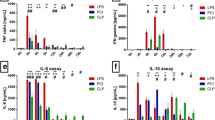Abstract
Mouse models of bacterial sepsis are widely used in research to investigate the underlying molecular mechanisms of sepsis and to develop clinically useful therapeutic regimens. Three commonly used mouse sepsis models include (a) injection of bacterial endotoxin, (b) infusion of cultured bacteria, and (c) cecal ligation and puncture. Here we describe the induction of bacterial sepsis in mice by intraperitoneal injection of cultured live Escherichia coli cells. The severity of the sepsis can be regulated by the number of E. coli cells injected into the peritoneal cavity of mice.
Access this chapter
Tax calculation will be finalised at checkout
Purchases are for personal use only
Similar content being viewed by others
References
Angus DC, van der Poll T (2013) Severe sepsis and septic shock. N Engl J Med 369:2063
Singer M, Deutschman CS, Seymour CW et al (2016) The third international consensus definitions for sepsis and septic shock (sepsis-3). JAMA 315:801–810
Doi K, Leelahavanichkul A, Yuen PS et al (2009) Animal models of sepsis and sepsis-induced kidney injury. J Clin Invest 119:2868–2878
Dejager L, Pinheiro I, Dejonckheere E et al (2011) Cecal ligation and puncture: the gold standard model for polymicrobial sepsis? Trends Microbiol 19:198–208
Wegiel B, Larsen R, Gallo D et al (2014) Macrophages sense and kill bacteria through carbon monoxide-dependent inflammasome activation. J Clin Invest 124:4926–4940
Chung SW, Liu X, Macias AA et al (2008) Heme oxygenase-1-derived carbon monoxide enhances the host defense response to microbial sepsis in mice. J Clin Invest 118:239–247
Pan H, Xu LH, Huang MY et al (2015) Piperine metabolically regulates peritoneal resident macrophages to potentiate their functions against bacterial infection. Oncotarget 6:32468–32483
Liu Y, Jing YY, Zeng CY et al (2017) Scutellarin suppresses NLRP3 inflammasome activation in macrophages and protects mice against bacterial Sepsis. Front Pharmacol 8:975
Zha QB, Wei HX, Li CG et al (2016) ATP-induced inflammasome activation and pyroptosis is regulated by AMP-activated protein kinase in macrophages. Front Immunol 7:597
Ren Y, Hua L, Meng X et al (2016) Correlation of surface toll-like receptor 9 expression with IL-17 production in neutrophils during septic peritonitis in mice induced by E. coli. Mediators Inflamm 2016:3296307
Long C, Wang Y, Herrera AH et al (2010) In vivo role of leukocyte ADAM17 in the inflammatory and host responses during E. coli-mediated peritonitis. J Leukoc Biol 87:1097–1101
Acknowledgments
This work was supported by the grants from the National Natural Science Foundation of China (Nos. 81773965, 81673664, and 81373423).
Author information
Authors and Affiliations
Corresponding author
Editor information
Editors and Affiliations
Rights and permissions
Copyright information
© 2021 Springer Science+Business Media, LLC, part of Springer Nature
About this protocol
Cite this protocol
He, XH., Ouyang, DY., Xu, LH. (2021). Injection of Escherichia coli to Induce Sepsis. In: Walker, W.E. (eds) Sepsis. Methods in Molecular Biology, vol 2321. Humana, New York, NY. https://doi.org/10.1007/978-1-0716-1488-4_5
Download citation
DOI: https://doi.org/10.1007/978-1-0716-1488-4_5
Published:
Publisher Name: Humana, New York, NY
Print ISBN: 978-1-0716-1487-7
Online ISBN: 978-1-0716-1488-4
eBook Packages: Springer Protocols




